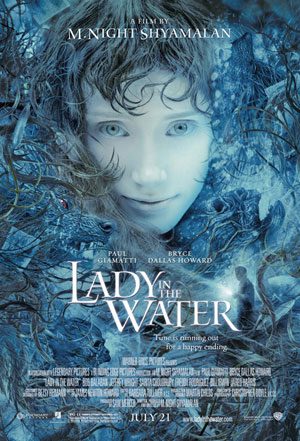 M. Night
M. Night
Shyamalan calls Lady In The Water a bedtime story, but I suspect
he wouldn’t know a fairy tale if it pissed on The Village. Granted,
somewhere at the bottom of this murky and repulsive water lurks the kernel of a
unique tale. But watching this film is like having Shyamalan punch you in the
gut before diving to find it.
Lady
In The Water is
a tale about stories — the Lady herself is even named Story — but more to the
point, it’s about how people really need to believe in and understand the value
of stories. Particularly if they’re told by Shyamalan. To make that loud and
clear he includes not only a smug film critic, but himself, portraying a man
destined to change the world. And that’s only part of what’s wrong with the film.
Paul
Giamatti, affecting and honest as ever, is Cleveland Heep, presumably named
after the locale of Giamatti’s breakthrough film, American Splendor.
(More on that in a moment.)
dislocated apartment complex. As frequently is the case with ugly apartment
blocks, this one is built around a swimming pool. In the pool is Story.
Story is
a Narf. We’re told that Narfs are sea nymphs with the power to inspire mankind.
In this case, the Narf is meant to inspire an individual, who will then
transform mankind. She’s hounded by a wolf-like beast called a Scrunt, and will
be retrieved by a giant eagle after performing her task. There’s also a
triumvirate of sorta evil monkey guys, but you won’t see much of them.
Value
those details. I gave valuable hours (two) and brain cells (countless) to
gather them. For this movie, Shyamalan tosses out the first rule of storytelling:
simplicity. Or elegance, I forget which one is actually the first rule. This
film has neither. The history and purpose of Narfs are explained through dreary
exposition, one scene after the other, relying on a Korean mother and daughter
perhaps borrowed from the Asian remake of a Telemundo soap opera shooting next
door.
The
Korean family is but two of many horrible characters inhabiting
stoners, the friendly Latin family with five shrill daughters, the Lady Who
Likes Animals. (Hopefully not this film’s sequel.) And I wanted to cry every
time Sarita Choudhury, as Shyamalan’s sister, opened her mouth to say yet
another thing that wasn’t funny. Remove Cleveland and his nymph, and you’ve got
a cast of characters UPN would never have allowed to sully even a pilot.
At first
I was completely put off by the insipid characterizations swirling around Cleveland
Heep. Then I realized that Shyamalan had mistaken stereotype for archetype. That
mistake, not the silly film critic, is one of many shots that sinks
In The Water.
this story unfold is the worst time I’ve had at the movies this year. There’s an
attempted level of meta-commentary, presumably about filmmaking and
storytelling, but Shyamalan is no Charlie Kaufman. By focusing on these film
school caricatures, he often forgets all about the bedtime story supposedly at
hand and can barely get any meta context together. Crucially, there is no
wonder, no joy, and no thrill at Story and the creatures that oppose her.
All we
get is a bunch of humans gamely trying to make it to the end of the movie. Their
place in the story is obvious from the beginning, so there’s nothing for us to
figure out. We wait until
together, by which time the possibility of any reward for us has escaped.
Not only
does Shyamalan treat these paper-thin and frequently shrill people as if they
were interesting, he literally casts some of their words as gospel. It’s one
thing to watch a bad story unfold in a halting, disaffecting manner. It’s
entirely another to be told over and over that it’s all terribly important. And
when one of the most important characters is portrayed by a flat, unlikable
presence (M Night Shyamalan) it gets even worse.
And with
that, Shyamalan has outdone his own self-indulgence. For while Bob Balaban’s
out of touch critic provides most of the movie’s lightest moments, Shyamalan can’t
let the movie go without promoting himself. Not only is Balaban a mouthpiece
for Shyamalan’s dismissal of critics, which gets in the story’s way every time,
the director himself is around to prove that his stuff really IS worthwhile. So
what is Lady In The Water really about? Stories and their value,
or critics and their lack thereof? I know which one I pick.
Oh,
right. That bit about American Splendor. That’s a movie that
achieved significantly wider notice due to critical approval. Without
unanimously glowing reviews, would the public have ever glanced at Harvey
Pekar? Unlikely. And yet in a film so determined to ignore and even destroy
critics, even at the expense of it’s own story, we’re continually reminded of
their better efforts. Thanks for the laugh, Night. It’s unintentional, I’m
sure.
2 out of 10